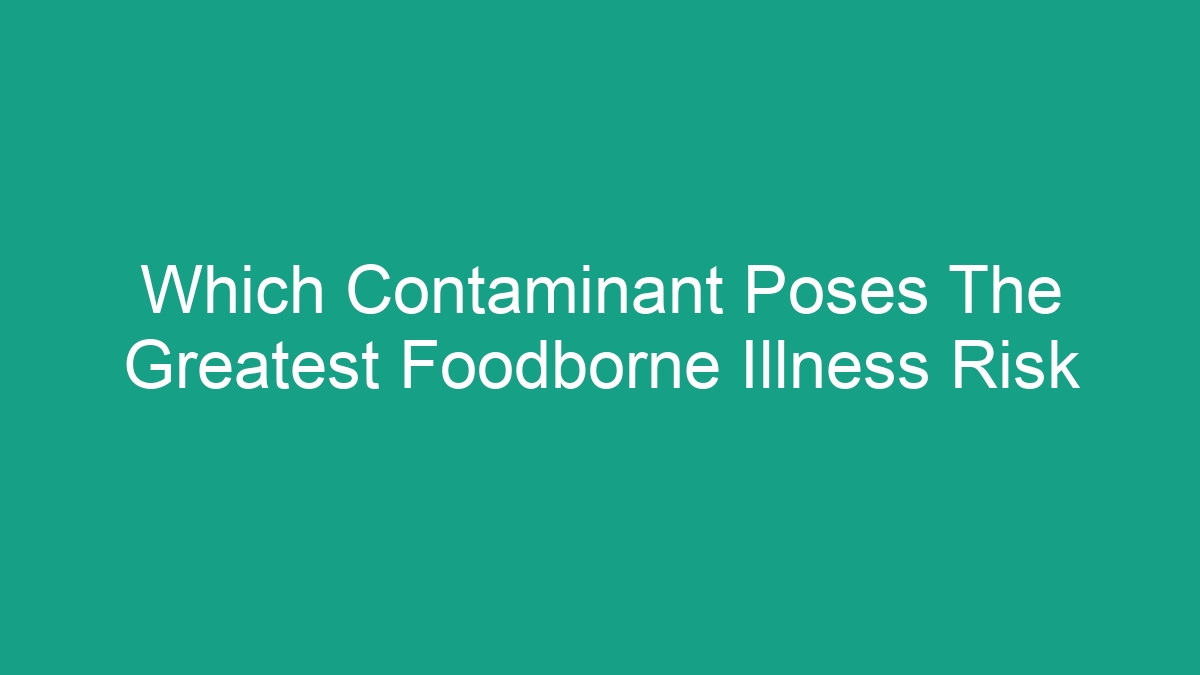
Food safety is a critical concern for both consumers and food producers. With the potential for various contaminants to cause foodborne illness, it’s important to understand which ones pose the greatest risk. In this article, we will explore the different types of contaminants and identify which poses the greatest foodborne illness risk based on current knowledge and research.
Types of Contaminants
Contaminants in food can be classified into several categories, including:
- Microbial contaminants: Bacteria, viruses, fungi, and parasites that can contaminate food and cause illness when consumed.
- Chemical contaminants: These include natural toxins, environmental pollutants, and chemicals used in food production and packaging.
- Physical contaminants: Foreign objects such as glass, metal, plastic, or wood that may accidentally end up in food products during processing.
Microbial Contaminants
Microbial contaminants are among the most common causes of foodborne illness. They can thrive in various food products and, when consumed, can lead to symptoms ranging from mild gastrointestinal discomfort to severe illness and even death.
Several types of microbial contaminants pose a significant risk to food safety:
- Salmonella: A common bacteria found in raw or undercooked poultry, eggs, and unpasteurized milk. It can cause salmonellosis, characterized by symptoms such as diarrhea, abdominal cramps, and fever.
- Escherichia coli (E. coli): Certain strains of E. coli, such as E. coli O157:H7, can cause severe illness. Contamination is often associated with undercooked ground beef and raw vegetables.
- Listeria monocytogenes: This bacterium can contaminate a variety of foods, including deli meats, soft cheeses, and unpasteurized milk. Listeriosis, the illness caused by Listeria, can be particularly dangerous for pregnant women and individuals with weakened immune systems.
- Norovirus: A highly contagious virus that can spread through contaminated food and water. It causes symptoms such as vomiting, diarrhea, and stomach pain.
- Clostridium botulinum: This bacterium produces a potent toxin that causes botulism, a potentially life-threatening illness. It can be found in improperly processed or preserved foods.
Chemical Contaminants
Chemical contaminants in food can originate from various sources, including agricultural practices, industrial processes, and food packaging. Some of the most common chemical contaminants include:
- Mycotoxins: These are naturally occurring toxins produced by certain types of fungi that grow on crops such as grains, nuts, and coffee beans. Aflatoxins, produced by Aspergillus fungi, are known for their carcinogenic properties.
- Heavy metals: Metals such as lead, mercury, cadmium, and arsenic can contaminate food through environmental pollution or certain food processing practices. Chronic exposure to heavy metals can have serious health effects.
- Pesticides and herbicides: Residues of these chemical substances can remain on fruits, vegetables, and other agricultural products, posing a risk to consumers’ health if ingested in high amounts.
- Food additives: While most food additives are safe for consumption, overuse or improper application can lead to adverse health effects. Certain food dyes, preservatives, and flavor enhancers have been linked to health concerns.
Physical Contaminants
Physical contaminants in food can be introduced during various stages of food production and processing. They pose a risk of injury or illness if ingested. Common examples of physical contaminants include:
- Foreign objects: Pieces of glass, metal, plastic, or wood can accidentally find their way into food products, posing a choking hazard or causing injury to the digestive system.
- Extraneous matter: This includes any non-food material that is not an inherent part of the food product and can compromise its safety and quality. Examples include insects, hair, and other contaminants not naturally present in the food.
- Allergens: While not always considered physical contaminants, allergens such as peanuts, tree nuts, wheat, soy, fish, and shellfish can pose a serious health risk to individuals with food allergies if not properly labeled and handled.
Greatest Foodborne Illness Risk
When it comes to determining which contaminant poses the greatest foodborne illness risk, several factors need to be considered:
- Prevalence: The frequency of occurrence of a specific contaminant in food and its potential to cause illness.
- Severity of illness: The degree of harm that can result from consuming food contaminated with a particular pathogen or toxin.
- Ability to proliferate: Some contaminants can rapidly multiply under favorable conditions, leading to widespread contamination of food products.
Bearing these factors in mind, it is evident that certain microbial contaminants present the greatest foodborne illness risk. Based on current knowledge and research, Salmonella, Escherichia coli (E. coli), and Listeria monocytogenes are among the primary culprits. These pathogens are known for their prevalence, ability to cause severe illness, and potential to proliferate in various food sources.
Preventing Foodborne Illness
Efforts to reduce the risk of foodborne illness focus on several key principles:
- Proper food handling and storage: This includes thorough cooking of meats, careful handling of produce, and appropriate storage of perishable goods to prevent microbial contamination.
- Effective cleaning and sanitation: Maintaining clean and sanitized food preparation and storage areas is crucial for preventing the spread of harmful contaminants.
- Regulatory oversight: Stringent regulations and inspections help ensure that food producers adhere to safety standards and take appropriate measures to prevent contamination.
- Education and awareness: Informing consumers about safe food practices, proper hygiene, and the risks associated with foodborne illness can help reduce instances of contamination.
Conclusion
While various contaminants can pose a risk to food safety, microbial contaminants such as Salmonella, E. coli, and Listeria monocytogenes are among the primary culprits when it comes to causing foodborne illness. Efforts to prevent and mitigate contamination include proper food handling, effective sanitation, and regulatory oversight. By remaining informed and vigilant, both consumers and food producers can work together to minimize the risk of foodborne illness and ensure the safety of the food supply.



